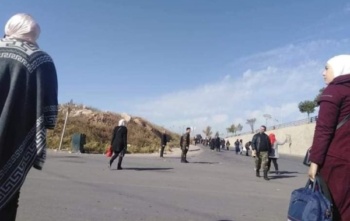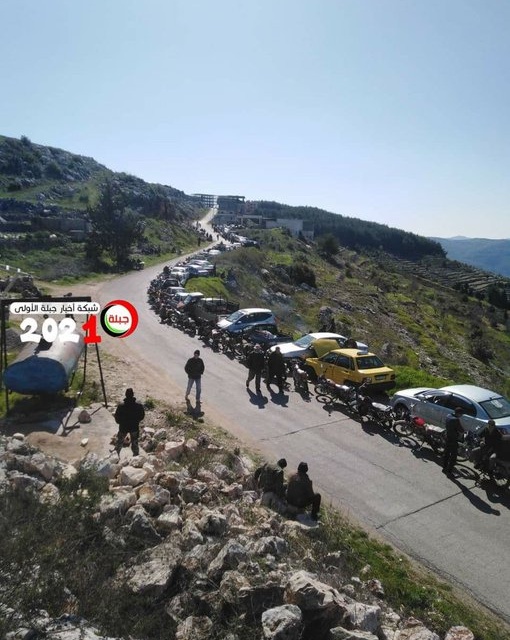A two-mile queue for petrol in a regime area of Syria, March 2021
UPDATE, APRIL 1:
A New York-based investment banker and prominent social media activist posts the latest image of the Assad regime’s fuel crisis:
Due to lack of fuel, transportation in most #Syria ‘s cities has ground to a halt. Public is having to use commercial vehicles to move around pic.twitter.com/2Z1WgElRux
— EHSANI22 (@EHSANI221) March 31, 2021
UPDATE, 1215 GMT:
Bashar al-Assad has proclaimed that the regime’s currency crisis is a “psychological war”.
The Syrian pound, which stood at 47:1 v. the US dollar at the start of the uprising in March 2011, now trades at more than 5,000:1 on the unofficial market. It has lost about 90% of its value since autumn 2018.
Assad has issued decrees threatening imprisonment of currency traders but has been unable to stem the sharp drop.
He defied reality on Tuesday night over the currency, “We have been able to gain achievements that were not previously done.”
Assad acknowledged the issue of inflation, but only to propose a solution through punishment: “Internal Trade Ministry must strongly intervene and urgently issue a new law that imposes deterrent penalties.”
ORIGINAL ENTRY: Pro-Assad activists testify to the fuel crisis in regime-held areas of Syria, including the capital Damascus, with two-mile queues for petrol.
British blogger Vanessa Beeley — embedded with the Assad regime to disseminate propaganda, disinformation, and denial of war crimes — tweeted on Wednesday: “Fuel queues are outrageous, people sleeping in car for 2 days #Damascus.”
She added that electricity is now limited to four hours each day, “many 3 hours per day”.
Another pro-Assad activist tweeted of a “massive public transportation crisis in #Damascus city with the ongoing fuel crisis”, posting photos of people standing in spaces void of buses and taxis.

The activists blamed US sanctions on the Assad regime, imposed over crimes against humanity, for the situation.
For most of the 10-year Syrian conflict, the regime has been dependent upon Iran for oil supplies, financed by billions of dollars in lines of credit from Tehran. But Iran, also under comprehensive US sanctions, is facing its own economic crisis, and the line of credit was only renewed last autumn after portracted negotiation. Iranian tankers have also been targeted by Israel.
The fuel shortage is also being fed by corruption, the banking crisis in neighboring Lebanon, and the regime’s loss of territory. Most of Syria’s oilfields are in the Kurdish-controlled northeast, after the US-backed Syrian Democratic Forces regained the territory from the Islamic State between 2017 and 2019.
Sunday Oct 22 of 2017 was a critical day in #Syria ‘s war
SDF, with air support from U.S Forces captured Al-Omar oil field from ISIS before #SyrianArmy was able to get there
This one incident is arguably responsible for much of the Eco challenges facing Damascus today
— EHSANI22 (@EHSANI221) March 30, 2021
With Damascus struggling to fill tenders for oil, wheat, sugar, rice, and other essentials, The Assad regime has cut fuel subsidies since last September. In January, it imposed another reduction in subsidized supplies — 24% of fuel and 17% of diesel supplies.
The head of the regime’s fuel products distribution, Ahmed Shamaat, promised at the time that the reduction would be temporary, insisting fuel will arrive “soon…depending on circumstances”, but he gave no date for the restoration of supplies.
Assad Regime Cuts Fuel Supplies
Syria: “Half of My Day is Spent Waiting for Bread”
With most Syrians making less than $100 each month, the cost of one liter of unsubsidized gasoline is 1,050 Syrian pounds ($0.37) on the black market while the subsidized price is 450 Syrian pounds ($0.16).


Trackbacks/Pingbacks